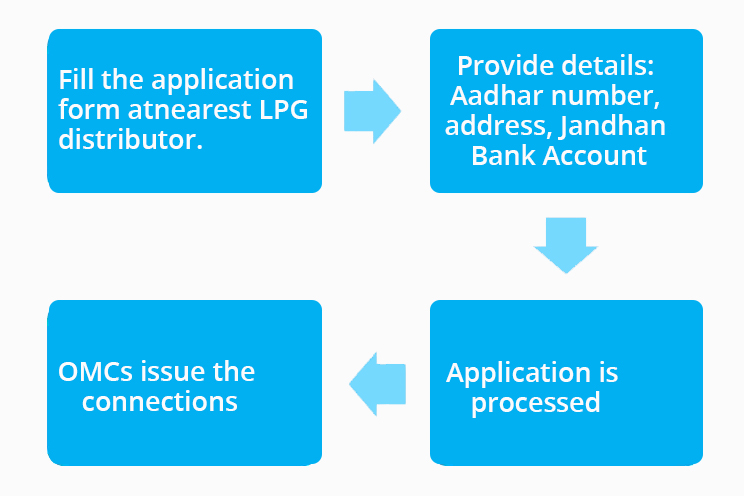 Introduction
Introduction
- On May 1st, 2016, Honorable Prime Minister Shri Narendra Modi launched the Pradhan Mantri Ujjwala Yojna (PMUY) in Balia, Uttar Pradesh.
- After the success of PMUY in Balia, the scheme was also introduced in Dahod in Gujarat, and several other districts of Uttar Pradesh and Bihar.
- The scheme began with the idea of providing around five crores Liquified Petroleum Gas (LPG) connections to Below Poverty line (BPL) families.
- Identification of these BPL families who require LPG connection is made through the Socio-Economic Caste Census Data.
- In addition to this, support of INR 1600 per connection is also extended to these BPL families for a period of next three years.
- The connections are issued in the name of the women of the household, especially in rural India.
- Till today, INR 8000 crore has been allocated towards the implementation of PMUY.
 PMUY
PMUY
Primary Aim:
- The primary aim of PMUY is to safeguard the health of women and children by providing them LPG connection, which is considered to be a clean cooking fuel.
- In this way, women are protected from the smokey kitchen environment, and they do not have to wander around the hazardous areas for collecting firewood. Thus, in a way it empowers women.
- PMUY is likely to produce around 1 lakh additional employment opportunities in the next three years. The same period will also provide a business opportunity of worth INR 10000 crores in India.
- The PMUY scheme is expected to give a boost to the 'Make in India' campaign as all the manufacturers of gas stoves, cylinders, gas hose, and regulators are domestic.
- In India, almost ten crore households are deprived of LPG as cooking fuel.
- These households rely on coal, cow dung cakes, firewoods, as their primary source of cooking fuel. These fuels emit alarming household pollution leading to adverse health effects on women and child health.
- One of the World Health Organization (WHO) Report claimed that the smoke inhaled by a woman from these unclean sources of fuel amounts to burning of 400 cigarettes in an hour.
- Moreover, women and children have indulged into the drudgery of collecting these sources of fuel such as firewood daily.
The process of applying for an LPG connection is given diagrammatically.
Given below are the details of the application process for LPG connection.
- Women belonging to a BPL household can apply for a new LPG connection in a prescribed format through the nearest LPG distributor.
- The women will have to submit details such as the complete address, Aadhar card number, and Jandhan Bank Account of all the family members at the time of submitting the application form.
- Once the application process is complete, the Oil Marketing Companies (OMCs) will issue the connection to the eligible beneficiaries.
- There is also an option for the consumer to opt for Easy Monthly Installments (EMI). On each refill, the amount of EMI is adjusted with the subsidy amount due to the consumer.
The Research Institute for Compassionate Economics (RICE) survey a random sample of 1550 households in 11 districts of Madhya Pradesh, Bihar, Uttar Pradesh, and Rajasthan. Collectively, these households were two-fifths of the country's rural population.
According to the study, the following observations were made on the implementation of PMUY:
Use of chulhas: The study revealed that most rural households who have taken LPG connections still use chulhas with dung cakes or firewood.
- Overall, only 27 percent of the households were exclusively using the gas stoves.
- Another 37 percent of the households were using both the chulhas and the gas stove.
- On the other hand, 36 percent of the households used chulhas exclusively.
- Due to the implementation of PMUY, 76 percent of household owned the LPG connection.
- Among those who have received an LPG connection, 53 percent of these households used chulha, and 32 percent of households used both media of cooking.
- Refilling the cylinder: Since the beneficiaries of PMUY are poor, for them the refilling of cylinder forms a greater fraction of their monthly consumption. Therefore, they are less likely to get refill immediately when a cylinder is empty.
- Seventy percent of respondents (who were mainly females) thought that the gas stove was better for the health of the cook.
- More than 86 percent of the respondents believed that cooking food on chulha was good for the health of the family.
| Short Form | Full Form |
|---|---|
| PMUY | Pradhan Mantri Ujjwala Yojna |
| LPG | Liquified Petroleum Gas |
| BPL | Below Poverty Line |
| WHO | World Health Organization |
| OMVC | Oil Marketing Companies |
| EMI | Easy Monthly Installment |
| RICE | Research Institute for Compassionate Economics |




